2 Media Technology and the Evolution of Language
By Dave Bostwick
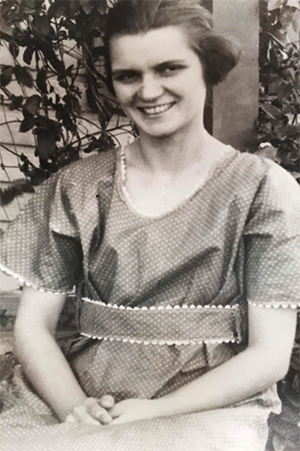 When silent movies became popular early in the 20th century, my grandmother (pictured here) had a part-time job improvising mood music on the piano to accompany the action on the screen. When popular movies began to include sound in the 1930s, local musicians lost their jobs as movie accompanists.
When silent movies became popular early in the 20th century, my grandmother (pictured here) had a part-time job improvising mood music on the piano to accompany the action on the screen. When popular movies began to include sound in the 1930s, local musicians lost their jobs as movie accompanists.
At the same time, the advent of recorded sound in movies led to new jobs for script writers, who could now craft language creatively in new formats. At the expense of some musicians, recorded words became an integral part of making movies.
This chapter shows how media history often repeats itself. The disruptive nature of media technology, which can affect jobs and language usage, did not start with my grandmother and silent films, though. For the next section, we’ll go back somewhere in the vicinity of 400 B.C.
But first, here’s a quick question about you:
YOUR MEDIA LANDSCAPE
To help you reflect on your own media interactions and literacy, many chapters in this OER text will open with narrative examples and first-person observations (such as the one above).
Related to the chapter introduction, how could your career and future work duties be impacted by current trends and advancements in mass media technology?
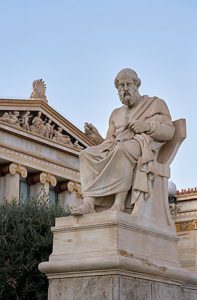 LETTERS
LETTERS
In Plato’s Phaedrus, Socrates recounts a legend about an Egyptian god whose “great discovery” was the use of letters for writing. He showed his discovery to a pharaoh, who feared the discovery would not lead people to wisdom. The pharaoh says …
“… this discovery of yours will create forgetfulness in the learners’ souls, because they will not use their memories; they will trust to the external written characters and not remember of themselves. The specific which you have discovered is an aid not to memory, but to reminiscence, and you give your disciples not truth, but only the semblance of truth; they will be hearers of many things and will have learned nothing.”
You should especially note the line saying that the introduction of letters for writing will give people “not truth, but only the semblance of truth.” That sounds a bit like our debates about misinformation and disinformation today.
Over the centuries, widespread adoption of written words led to less emphasis on oral storytelling traditions passed from generation to generation. The best storytellers and philosophers eventually became writers.
And as writing became a way for information and ideas to spread, some rulers sought to control what their people read. Way back in approximately 200 B.C., China’s first emperor, Qin Shi Huang, directed his officials to destroy classic cultural books in history and education. Today’s historians believe the emperor did not want the Chinese people to compare his rules to the teachings of Confucius.
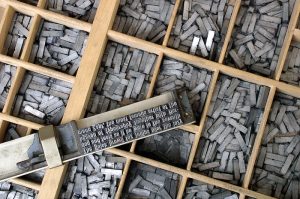 MOVABLE METAL TYPE
MOVABLE METAL TYPE
Most historians credit the Chinese with the first printing technology that used movable type. In Europe, Johannes Gutenberg’s 15th-century innovations using movable metal type enabled mass distribution via the printing press.
The invention of the printing press led to attempts to regulate who could have one. In The Death of Truth, Steven Brill wrote that the early printing press “was seen as a breakthrough in advancing learning and knowledge, but also seen as a powerful weapon if used by the wrong people.”
The printing press soon impacted language evolution. Before the printing press, spellings were inconsistent due to regional dialects and evolved quickly with pronunciations. If you study the English author Chaucer, for example, you may come across old texts that use cnicht or knyght where today we consistently spell knight.
Here’s a brief video that emulates spelling and pronunciation from Chaucer’s day, around the year 1400.
Back then, speakers would have pronounced knyght to include all those consonants. As one English instructor said in a video tutorial, you have to pronounce everything and “get phlegmy with it.”
Over the centuries, as printed materials were commonly distributed, the spelling of English words became more formalized, and dictionaries became part of the language landscape. Some linguists use the term fossilized to describe words that are spelled the way they were pronounced during the adoption of the printing press. Consider, for example, the inconsistent sounds in these examples that all end in -ough:
- Through
- Thorough
- Trough
- Rough
- Bough
Because of the printing press, many English spellings remain largely unchanged from centuries ago, while pronunciations have evolved. The printing press also led to the need for a new group of language workers, called lexicographers, to compile dictionaries.
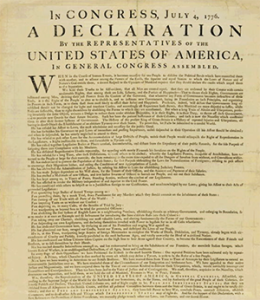 SENTENCE LENGTH
SENTENCE LENGTH
Let’s focus on the infancy of American English, specifically the year 1776. Here is the opening of The Declaration of Independence:
When in the Course of human events, it becomes necessary for one people to dissolve the political bands which have connected them with another, and to assume among the powers of the earth, the separate and equal station to which the Laws of Nature and of Nature’s God entitle them, a decent respect to the opinions of mankind requires that they should declare the causes which impel them to the separation.
Compare the opening sentence of the U.S. Declaration of Independence to this excerpt of three sentences from Ernest Hemingway’s novel The Sun Also Rises, which was published in 1926.
It was a fine morning. The horse-chestnut trees in the Luxembourg gardens were in bloom. There was the pleasant early-morning feeling of a hot day. I read the papers with the coffee and then smoked a cigarette.
In 150 years, how did American English evolve from the free-flowing structure of the Declaration of Independence to Hemingway’s sparse style?
Part of the answer lies with advances in media technology. The brief presentation below chronicles a few developments that affected the evolution of our language.
Study the following presentation slides by using the forward button or clicking on sections of the control bar. To enlarge any interactive presentation in this book, click on the lower-right full-screen option (arrows).
As a side note, in his book The Gutenberg Parenthesis, Jeff Jarvis wrote that because the telegraph allowed “instantaneous communication with unseen strangers,” there were initial concerns about “stranger danger.” Some stakeholders thought jobs in the new telegraph industry were inappropriate for women.
RADIO, TELEVISION, THE INTERNET …
Our media technology continues to affect our language usage in ways we don’t fully realize yet. Here are a few current examples.
- Texting (capitalization, shortened spellings, emojis)
- Search-engine optimization techniques that emphasize keywords
- AI-generated text
Many Americans today fear the consequences of our 21st-century tech evolution, much like philosophers feared the danger of written text in Socrates’ day. And in the late 20th century, some research suggested that watching too much television would hinder children’s language development.
As a recent example related to language usage, in 2023 a few state legislatures mandated cursive writing in public schools so that students do not rely entirely on digital keyboards for writing. One theory holds that cursive writing is more conducive to individual student thinking and learning.
Consider how the communication devices you use today may affect the way you write in the future.
@emojis
FWIW: i think declare of indy wld be diff today / LMK ur thoughts
Will all 📚 soon be printed with emojis that represent 🙀 or 💩 or 🏈? How could that change the way we define literacy?
MORE ABOUT ARTIFICIAL INTELLIGENCE AND WRITING
We can only guess how AI tools may change our future language usage. Large language models (LLMs) use algorithms that can analyze speech and generate words and phrases in context. If you text on a smartphone, for example, you may have noticed that as you type a text message, the app displays commonly used words that attempt to predict what you may want to type next.

In an online journalism course sponsored by the Knight Center, Sil Hamilton, a language-model researcher, provided the simple example summarized below.
The United States of __________
In a large percentage of instances, an AI tool (such as Chat GPT) will generate America as the next word. You can ask the tool to regenerate a response multiple times, but you may never get the word Pizza.
On the other hand, if I’m looking for something interesting to read, I’m more likely to engage in a story with this title:
The United States of Pizza
AI tools can work well to give us predictable (sometimes boring) text, but their level of creativity is debatable.
For a conceptual overview of language models, study the following interactive presentation.
We’ll see new employment opportunities and job titles for people who can skillfully use AI tools to generate, edit and publish useful and reliable text. For example, AI programs already require a vast amount of gig workers who sift through and clean language banks that train large language models.
Ironically, the BBC reported that there are jobs for copy editors who rewrite AI-generated text to make it sound more human and thereby avoid AI-detection software.
And some media platforms embed AI text-generating and editing tools. For example, LinkedIn gives premium subscribers an option to click “Rewrite with AI.” One analysis summarized in Wired magazine estimated that “over half of longer English-language posts on LinkedIn are AI-generated.”
FUTURE CONCERNS ABOUT LARGE LANGUAGE MODELS

One impending concern for LLM developers is that their products are consuming high-quality data faster than it is produced. According to Epoch, a research institute, tech companies could run out of data in the late 2020s.
In their search for more and more language data, both Google (Gemini) and OpenAI (ChatGPT) have harvested text from YouTube videos, brushing aside copyright considerations.
OpenAI founder Sam Altman predicted that tech companies will eventually train their AI products on previous text generated by AI — also known as synthetic data. According to a New York Times article about AI data harvesting, “Since an A.I. model can produce humanlike text, Mr. Altman and others have argued, the systems can create additional data to develop better versions of themselves.”
However, some analysts fear that AI-generated text derived from synthetic data will be less reliable and more prone to algorithmic manipulation.
Also, a research analysis from Columbia Journalism Review, titled “How ChatGPT Search (Mis)represents Publisher Content,” found that human journalists face a great risk of their work being misattributed or misrepresented.
Researchers experiments with ChatGPT “revealed numerous instances where content from publishers has been cited inaccurately, raising concerns about the reliability of the tool’s source attribution features.”
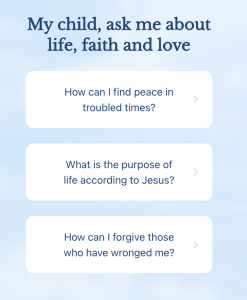
And as a closing example of the continuing evolution of large-language models, Americans have mixed opinions about the increasing popularity of religion-based chatbots such as Bible Chat and Jesus AI.
These chatbots rely on religious texts as data sources to engage users in spiritual conversations, in some cases including user confessions.
The Jesus AI site even contained a disclaimer: “The Jesus AI is not meant to replace or represent any religious figure. The generated content is for educational purposes only and may contain inaccuracies and biases.”
RECAP
Here’s a simple chronological overview to hammer home the disruptive nature of media technology.
- Letters disrupted an oral tradition.
- The printing press disrupted the tradition of handwritten manuscripts.
- The telegraph disrupted tangible (printed) media.
- Radio disrupted the evolution of the telegraph.
- Television disrupted the entertainment model of radio.
- The internet disrupted the evolution and popularity of TV, radio, movies, newspaper, books and magazines. It has changed how we define them.
- Computer-generated words and images have forced us to reconsider ownership and appropriate use of content derived from non-human sources. (However, we don’t yet know the extent of disruption caused by AI-generated content.)
Because of this continually disruptive process over hundreds of years, many workers, such as piano players for silent movies, have been forced to adapt to new media environments.
CLOSING – A NEW DECLARATION
The opening sentence from the Declaration of Independence seems clunky today. Let’s use an AI tool to rewrite it as a hipster version.

FILL IN THE BLANKS
PREDICTING THE FUTURE
You’ve read two chapters that discuss media technology and evolution. Now, your mission is to predict changes in U.S. media usage in the next 50 years, including effects on how we use language.
- Based on the two chapters you’ve studied so far and personal experiences, what significant changes do you foresee in the delivery of information and entertainment?
- What type of content will consumers deem valuable, and how will the economics of mass media evolve?
- How will today’s newest media technologies affect how we communicate and use language in the future?
You are free to find other trustworthy sources to support your predictions, possibly through a library database. Instead of merely listing your predictions, be sure to cite supporting information from this text chapter and outside sources.
You can write your response in paragraph text, typically between 200 and 300 words. To follow journalistic style, you should write crisply with no more than three or four sentences per paragraph.
For this assignment, you may prefer to respond through audio or narrated video.

